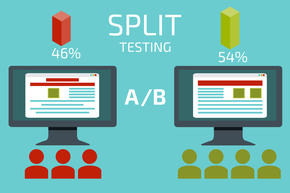CALL US TODAY: (877) 786-3249 x3
Schedule a Strategy Session
Getting to know which aspects of your online marketing campaigns resonate the best with your target market may not always be straightforward. With so many variables involved and a broad population to attract, it’s important to test the content you send out. One way to do this is through A/B split testing. A/B split testing involves modifying a single element in your emails, web pages, pay-per-click ads, and other online campaigns, and sending out two versions to determine which version resonates better with your audience.
 The objective for A/B testing is to increase your conversion rate, or actions taken by your customers, such as clicking a call-to-action button, text link or navigation link. To be effective, you must first take a big-picture view of your audience. That view starts with questions that include:
The objective for A/B testing is to increase your conversion rate, or actions taken by your customers, such as clicking a call-to-action button, text link or navigation link. To be effective, you must first take a big-picture view of your audience. That view starts with questions that include:
Once you have answers to these three important questions you can begin testing audience segments across your various online marketing channels. Three of the most common marketing channels to test are email, website pages, and pay-per-click (PPC) ads. Each has its own set of variables to test.
Email Marketing is a great channel to nurture existing leads, and bring in new ones. Typically, you can test what works with your subscribers through trying different subject lines, send times, and content in each email blast you send. However, depending on your email cycle, testing in this fashion could take a long time to determine what is working for your audience.
With A/B split testing you can test a variety of elements in a single email blast, preventing lost sales, and saving you time. While there are a lot of elements you can test, it is important that you limit yourself to modifying one variable at a time when A/B testing. This allows you to easily determine which variable led to more conversions/engagement. Elements you can test include:
When you’re analyzing email campaign results, check which version of your blast received the best metrics. This will help provide you with insight into which elements and variations are working best for your subscribers.
Some email clients allow you to test a small sample of your subscriber base. For example, 10% of your subscribers will receive subject line A, while another 10% receives subject line B. If subject line B sees 25% more opens within an hour, the email client will send your email blast with subject line B to the remaining 80% of your subscribers. This helps automate your split testing process and makes sure the majority of your subscribers receive the best possible version of your email blast to create an effective email marketing campaign.
Pay-per-click advertising is a key component of many online marketing campaigns and can often be one of the most expensive online marketing costs. Because of this, it is key that you test your ads regularly. PPC testing involves fewer elements to test, so changes to your content during A/B testing can make a big impact on conversion results.
Typically, you’ll want to test each of the following elements:
During A/B testing for PPC ads, you’ll want to track how many click-through each ad is getting, and how many conversions those clicks lead to. Make sure to set your ads to rotate evenly. If Google is set to optimize how the ads are displayed, one may be shown more than the other, skewing your A/B data. To see significant results, you’ll want to test for a few days to a couple of weeks, depending on your traffic volume. See how you can further optimize ads with PPC TLC.
Web pages contain a myriad of elements that can be tested using A/B split testing. The position, color, size and text of an element can all be modified and tested to see what works for your target market. For each page, test the following:
You’ll want to look at the page layout, including the arrangement of menus, buttons, forms, scrolling content, video players, and banner ads, if applicable. Results can be seen in how visitors navigate through pages and how they move to your shopping cart or other conversion pages.
Knowing exactly how to get your target audience engaged in your online marketing initiatives can be a tricky endeavor. A/B split testing helps establish a track record of data that will help you determine exactly what content will get and keep your audience engaged. To learn more about A/B Split Testing, and how to produce engaging content, contact us today!
